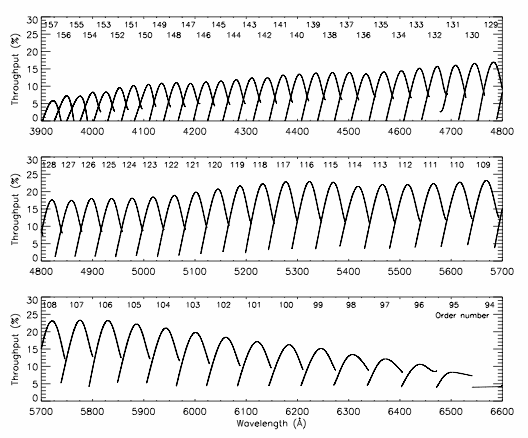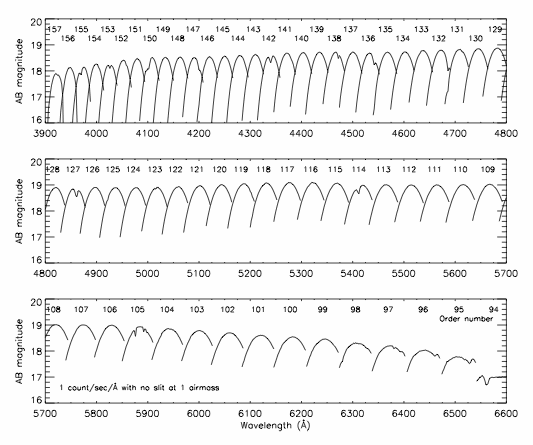|
For more detailed information than the summary specs presented below,
please see the SPIE papers. Note that the STA1600 CCD was installed in
Fall 2018, subsequent to the SPIE publications.
Wavelength range: Fixed format covering 391 to 734nm.
Slits and Resolving Power:
| Width (") | Length (") | Resolving Power |
Comment |
| 0.3 | 2.5 | 127,000 | Default as of 2018 |
| 0.5 | 2.5 | 76,000 | Default prior to 2018 |
| 0.7 | 2.5 | 54,000 | |
| 0.2 | 3.7 | 190,000 | |
| 0.3 | 3.7 | 127,000 | |
| 0.5 | 3.7 | 76,000 | |
| 0.7 | 3.7 | 54,000 | |
| 1.0 | 3.7 | 38,000 | |
| 0.7 | 10 | 54,000 | Orders overlap |
| 3.0 | 3.7 | N/A | For efficiency
evaluation |
| 0.7 | 3.9 | N/A | For Wide Flats |
| 0.3 | - | N/A | Pinhole; For Focus |
Scale and Dispersion: 0.054 arcsec/pixel, ~0.009 Angstroms/pixel
Velocity precision: 1 meter/sec
Detector: STA1600 CCD, 10K x 10K, 9 micron pixels.
Non-linearity data
| Speed | Read Noise (e-) | Gain (e-/ADU) |
Readout time (sec) |
| Normal (250 kHz) | 3.59 | 2.29 | 62 |
| Turbo (100 kHz) | 4.14 | 2.30 | 26 |
Slit viewer field of view: 38x38 arcsec
Calibration sources: Thorium Argon lamp, Quartz lamp, Iodine
absorption cell
Practical faint magnitude limit: Somewhere between V=15 and V=16,
limited by star visibility in slit viewer
Efficiency: Peak instrumental efficiency is around 23%
|
Instrumental efficiency from entrance aperture to detector.
This does not include slit losses, telescope efficiency, or atmospheric
absorption, but does include the QE of the CCD.
|

|
|
AB magnitude zero point.
This is the AB magnitude of an object from which one expects to receive 1
electron/sec/Angstrom at 1 airmass without a slit. Depending on the airmass,
seeing, and choice of slit, actual count rates will be lower.
|

|
|









